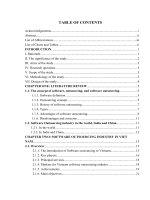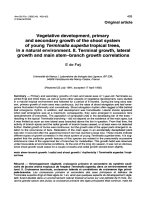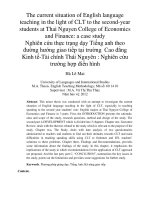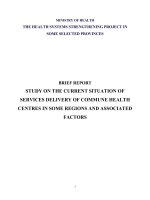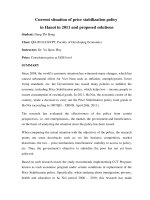Current situation of working attitude of young officers at research institutes in Hanoi city
Bạn đang xem bản rút gọn của tài liệu. Xem và tải ngay bản đầy đủ của tài liệu tại đây (468.49 KB, 10 trang )
HNUE JOURNAL OF SCIENCE
Social Sciences, 2020, Volume 64, Issue 4D, pp. 86-95
This paper is available online at
CURRENT SITUATION OF WORKING ATTITUDE
OF YOUNG OFFICERS AT RESEARCH INSTITUTES IN HANOI CITY
Tran Thi Ha1 và Le Thi Ngoc Thuy1
1
Faculty of Primary Education, Hanoi National University of Education
2
Institute of Psychology, Vietnam Academy of Social Sciences
Abstract. Working attitude is one of the factors that makes work performance of people in
general, and of young staff in particular. Survey results on 191 cadres with less than 10
years of experience in Vietnam Academy of Science and Technology and Vietnam
Academy of Social Sciences showed that they have certain efforts in their current job.
There was relative satisfaction with the current job. There was no difference in attitude
working among young cadres according to gender and workplace, but there was a
difference in degree of satisfaction with management by seniority, that differences was
statistically significant. At the same time, job satisfaction will create positive changes in the
work of young staff.
Keywords: working attitude, young staff, job satisfaction, job performance.
1.
Introduction
To become a good employee, besides having professional knowledge, a positive-working
attitude is indispensable. Changing positive attitude has a great impact on work efficiency
(Richard E. Petty et al. (2014), William D. Crano and Radmila Prislin (2010). A positive
attitude requires each individual to constantly look back at himself, to experience by himself in
order to learn how to view and solve problems in a positive and professional manner. There is
a consistency between attitude and behavior (William D. Crano, Radmila Prislin (2010). In
Dolores's research also showed that the formation and change of human attitude in each
context has different manifestations. Firstly, attitudes change with regard to values, common
goals, language, emotions and human development. The second context is social relationships,
changing attitudes makes relationships among people more empathetic, persuative and easier
to achieve common goals (Dolores Albarracin and Sharon Shavitt (2018) 1, 2, 3.
Young cadres are considered a core workforce of a nation, greatly contributing to the
building and enrichment of each country's economy. Therefore, studying the working
attitude of young cadres in general and young cadres at research institutes in Hanoi city in
particular is especially essential to help readers have a general view of the current situation
of their working attitude, identifying the objective and subjective factors that affect their
working attitudes, from which it is enable to take measures to improve the positive working
attitudes of young cadres.
Received April 13, 2020. Revised April 23, 2020. Accepted May 11, 2020.
Contact Tran Thi Ha, e-mail address:
86
Current situation of working attitude of young officers at research institutes in Hanoi city
2.
Content
2.1. Research overview and principal concepts
In psychology, attitude issues attract concern of many scientists and they have given
different points of view about these. The tendency to regard attitudes consists of following
elements: cognitive, emotional, behavioral or supportive or anti-objective reactions stemming
from beliefs, emotional expressions and behavioral orientation, mentioned by Norbert Schwarz,
Gerd Bohner (2001), Myers DG (2010). Some authors have considered that attitudes include
evaluating, liking or disliking any object or phenomenon (Timothy A. Judge and John D.
Kammeyer - Mueller (2012). Others argued that the attitude is “a positive or negative opinions
of an object” (Knud Larsen and Le Van Hao (2010), Malhotra (2005)) 4, 5, 6, 7, 8.
First of all, it must be asserted that young cadres are people who engage in specific
occupational activities. Being people who participate in occupational labor, especially in
professional activities, young cadres are those with educational attainment who have graduated
from upper secondary schools and from vocational training levels from intermediate level
upwards. They have professional knowledge in ocupational fields.
Secondly, mentioning about young staff, we can talk about age and / or seniority. They can
be understood as young cadres in terms of age or terms of working age (not many seniority in
working). Therefore, when discussing the concept of young staffs, we need to consider their age
and / or seniority.
Within scope of this article, the research objects are young cadres who are mainly working
at a number of research institutes. Researchers are research staffs or they may be referred to as
scientific staff. In some documents of our Party and State, young scientists are usually
determined by age criteria; they are scientific staff at youth age. Article 1 of the Youth Law
determines that the youth age is from 16 to 30 years old. However, the Ninth National Congress
(2007) and the Tenth Congress (2010) of Ho Chi Minh Communist Youth Union amended the
charter and stipulated that the age of union members is from 16 to 30 years old, while in the
Charter of the Vietnam Youth Union, young people are aged between 15 and 35 years old. The
inconsistency of the texts in determining youth age can make it difficult to assess the position,
role and characteristics of young people, and also when making policies for them (La Thi Thu
Thuy, 2012) 9, 10.
In some scientific studies, some of the concepts equivalent to the concept of young
scientific cadres have been mentioned, including young intellectuals or intellectual youth and
the age is one of the criteria to define these concepts. Ngo Thi Minh Phuong said that young
intellectuals, who are between the ages of 22 and 39, must be trained through tertiary education
(cited by La Thi Thu Thuy, 2012, p. 28). In the intellectual youth’s study, La Thi Thu Thuy et
al. (2012) identified: Young intellectuals are understood as intellectual workers, educated from
university or equivalent levels, whose age from 23 to 35 years old, with professional knowledge
in their careers. Their activities are creative and meaningful to society. These studies comprise
the youth span wider than the Government's Decree No. 140/2017 / ND-CP of December 5,
2017, but in accordance with the Politburo's Conclusion No. 86 / KL-TW. In these studies, the
concept of youth not only determines the age but also the seniorits of intellectuals 10, 11.
Our research is conducted on the subjects who are working at the research institutes. This
specific job requires not only knowledge and skills at work, but also psychological experience
of himself on daily livings. Therefore, according to opinions of the research team, the time for a
young researcher to mature and be stable at work is about 10 years. Based on the above analysis
of characteristics of age and working experience, we believe that young employees are
87
Tran Thi Ha and Le Thi Ngoc Thuy
understood as specific occupational workers who have professional training qualifications from
intermediate level or higher, with a working period of 10 years or less.
In this study, the working attitude of young cadres is considered as the effort at work, the
attachment to the job, the agency and their satisfaction with the job.
2.2. Methods
In order to find out the actual situation of young cadres’ working attitudes at research
institutes in Hanoi, the research team conducted surveys to 191 officers with working
experiences of less than 10 years and currently working at Vietnam Academy of Science and
Technology (accounting for 52.1%) and Vietnam Academy of Social Sciences (around 47.9%).
In this study, working attitude of young employees' is measured by their effort at work,
their commitment to work and their agency; their satisfaction with the job.
Efforts at work are assessed on a scale of 0 to 10 (0 points means that having no effort at
work while 10 points is regarding for much efforts to work).
The scale for job satisfaction consists of 3 parts: satisfaction with job characteristics (5
clauses), satisfaction with colleagues’ relationship at work (2 clauses) and satisfaction with the
management and administration of leadership at work (4 clauses). Each proposition has 4
answers with 4 points: 1 point - completely wrong, 2 points - mostly incorrect, 3 points - mostly
correct, 4 points - completely correct. The higher average score of each clause is, the higher
agreement of the respondent with the content of the clause are. That means individual is highly
satisfied with the job
Data collected from the questionnaire is processed by mathematical statistical methods via
SPSS software. After calculating the reliability, the scale of job satisfaction has Alpha reliability
is 0.989.
2.3. Results of searching situation
2.3.1. Actual situation of working attitude of young cadres at research institutes
The results of youth’s self-assessment about the efforts in their own work according to 10point scale are: 100% of surveyed young staff rated their efforts in work at an average level and
above (from 5 to 10 points), focusing mostly on point 8 (37.2%) and point 7 (32.5%). This
means that young staff in research institutes all considered themselves to have relatively
positive efforts at work.
Although young staff at research institutes all assessed themselves to have a quite positive
effort, when being asked “If you selected again, would you still choose your current career?”, up
to 53 , 4% of them answered “yes”, 35.6% were still “confused”, only 11% of respondents gave
“no” answer. Clearly, the majority of interviewed young staff expressed their commitment to
their current occupation. There are many reasons given by young cadres to explain why they
wouldn’t choose the current job again, such as: the job is not correspongding with their
professional (3 selected participants), the income does not guarantee for their daily life (14
choosen people), the current job does not promote their forte (4 options), not being interested in
career (2 options), having chosen the wrong job (4 options). Although the number of
respondents choosing the current job is more than half, the number of people who are
wondering and do not really want to choose the current job with different reasons is also not
small. It can be seen that, the adherence to the career of young people nowadays is generally
relative because of open society, job opportunities leading to job shifts are also the trend of
society. This was also confirmed when up to 45 respondents (23.8%) wanted to change the
workplace and 72 people confused (37.7%). The reasons for wanting to change the workplace
most are that salary is not guaranteed for their life (35 people choose); working environment
88
Current situation of working attitude of young officers at research institutes in Hanoi city
does not facilitate development (9 options), like to explore in other new workplace (8 options);
working environment does not allow them to express their own ideas (6 options). Thus, the
survey results about young staff’s commitment to occupation and working places at research
institutes in Hanoi city showed that many of them do not have a deep adherence to the
profession as well as their workplace.
One of the factors which expresses working attitude of young cadres is their satisfaction
with their job. The results are presented in Table 1 below
Table 1. Degree of satisfaction with job characteristics of young cadres
No
Job characteristics
Mean
Std
1
You are satisfied
with the nature of
the current job
2.62
0.76
8.9
You are satisfied
with the current
working intensity
2.71
0.71
You are satisfied
with your current
performance
2.57
You are satisfied
with the income
from your current
profesional work
You are satisfied
with the conditions
and means of work
2
3
4
5
Total
Mostly
correct
Completely
correct
28.4
54.7
7.9
5.8
26.8
58.4
8.9
0.73
6.8
36.3
49.5
7.4
2.16
0.78
19.5
48.4
28.4
3.7
2.62
0.81
9.0
31.7
47.1
12.2
2.54
Completely Mostly
incorrect incorrect
0.54
The data in Table 1 shows that the degree of satisfaction of job characteristics is moderate
(ĐTB = 2.54 / 4), that means, young staff are relatively satisfied with the current job
characteristics. As follows:
Young cadres expressed the most satisfaction with their current work intensity (Mean =
2.71 / 4) with 58.4% of respondents rated the proposition as mostly true and the same with the
average of 2.62 / 4 showed the satisfaction of the subjects with the nature and conditions,
means of work, less satisfied was with the income from professional work (2.16 / 4) with 48,8%
of respondents rated this clause as largely incorrect. NTH, 30 year-old researcher said: “In fact,
the current working conditions and facilities have been improved day by day, the work intensity
is also suitable for us; however, the salary issue is the great problem that makes us most
dissatisfied. Although we know this is policy of the Party and the State, we still have to arrange
extra work to increase income. “
The data in Table 2 shows the degree of satisfaction of young cadres with the relationship
among colleagues. In general, they are quite satisfied with this relationship (Mean= 2.65 / 4). In
terms of two specific expressions, namely “satisfaction with the support and cooperation of
colleagues at work” and “satisfaction with sharing and encouragement of colleagues on non89
Tran Thi Ha and Le Thi Ngoc Thuy
work issues”, there are nearly the same average (2.65 and 2.65). It can be said that the
relationship between young staff and co-workers is relatively good in both mentioned terms.
This is the basis for working people to have a good working attitude because positive working
relationships are considered the path to success (www / cleverjobs.vn /).
Table 2. Young cadres' satisfaction in relationships with colleagues
No
Relationship with
colleagues at work
1
2
Mean
Std
Completely Mostly
Mostly Completely
incorrect incorrect correct
correct
You are satisfied
with the support
and cooperation of
colleagues at work
2.64
0.76
7.9
29.6
52.9
9.5
You are satisfied
with the sharing
and encouragement
of colleagues on
non-work issues
2.65
0.73
6.3
30.7
54.5
8.5
Total
2.65
0.70
In addition to being satisfied with their co-worker relationship, the authors also explored
the degree of satisfaction of young staff with the management and administration of their
executives. The results are shown in Table 3.
Table 3. The degree of satisfaction of young staff
with the leadership management at their office
No
1
2
3
4
90
Leadership
Mean
management at work
Std
Completely Mostly Mostly Completely
incorrect incorrect correct
correct
You are satisfied
with the way of
assigment of the
leaders at work
2.66
0.73
7.4
27.5
57.1
7.9
You aren satisfied
with the way of
assessment of the
agency leaders to
employees’
performance
2.66
0.72
6.9
28.0
57.1
7.9
You are satisfied
with
the
way
appointing
personnel at your
office
2.63
0.76
8.5
28.0
55.0
8.5
You are satisfied
2.66
0.78
6.3
34.4
46.6
12.7
Current situation of working attitude of young officers at research institutes in Hanoi city
with the penalty and
reward regime at
your institution
Total
2.65
0.64
The average score of the degree satisfaction with the management of the leadership is quite
good (2.65 / 4, standard deviation (std) = 0.64). This shows that young employees are satisfied
with the leaders’ management. More than half of the respondents answered the propositions: the
way of assigning jobs, evaluating job performance, and appointing personnel are mostly
correct. However, nearly 30% of them rated mostly incorrect. The satisfaction with the regime
on how to appoint personnel at the agency is somewhat less (Mean = 2.63 / 4).
Mentioning about satisfaction with the way of administration and management of the
leaders, Mr. Tr. T. D (33 years old) said: “In general, the leaders currently know how to show
democracy and fairness at what they do, but it does not mean that we are totally satisfied with
their ways of managent: we sometimes recognize that the manner of personnel appointment is
not really reasonable or punishment regime at the agency is not really clear, etc. However,
leaders and staff have been also looking for the most appropriate way to solve everything in
order to obtain the sympathy and satisfaction of all officials at the agency”.
The satisfaction related to job characteristics is somewhat less in young cadres (Mean=
2.54 / 4 and Std = 0.54); in which young staff expressed the most satisfaction with the current
work intensity (Mean = 2.71), followed by satisfaction with the nature, conditions and means of
work (Mean = 2 , 62). Among the job characteristics group, the least satisfied of young staff
was the income from professional work (Mean = 2.16). This was also the point where they are
most dissatisfied (the total proportion accounted for 67.9% at two scale including completely
dissatisfied and most dissatisfied). This result is quite similar to a previous study by La Thi Thu
Thuy and colleagues (2012) when evaluating job satisfaction of intellectual youth. A 30-year-old
cadre considered : “In fact, the conditions and working facilities have been improved day by day, the
work intensity is also suitable for us; however, salary issues are the ones that make us most
dissatisfied. Although we know this is a mechanism and policy of the Party and the State, we still
have to arrange extra work to increase income” (female researcher, 30 years old).
In belief, the situation of working attitude of young cadres at research institutes in Hanoi
shows that: they have made a certain effort in their current jobs, many subjects assessed their
efforts at a high level. Many of them were not really attached to their current jobs and
workplace because of various reasons. Satisfaction with the job is generallly assessed at a
relative level, not many of them are really satisfied with the current job.
2.3.2. Actual state of working attitude of young cadres at research institutes in Hanoi
compared with variables
Comparing the average score of young staff’s working attitude in research institutes
showed that:
There was no difference in the working attitudes of young cadres by gender (male and
female). It can be said that the male and female researchers participating in the study all had the
same attitude towards their current job (Table 4).
There was difference in satisfaction with the management and administration of leaders in
workplace among groups of working years (sig. 0.047 <0.05) (table 5). In which, the group of
cadres with less than 3 years of work illustrated the highest satisfaction (mean = 2.75), ranked
second was the group of cadres over 6 years working (mean = 2.71), showing the least satisfied
was the group with 3-6 years of work (mean = 2.49).
91
Tran Thi Ha and Le Thi Ngoc Thuy
Table 4. Young staff's working attitude towards gender parameters
Male
Female
p
Mean
Std
Mean
Std
Working efforts
7.50
1.06
7.51
1.15
0,94
Satisfaction with the job characteristics
2.56
0.56
2.52
0.53
0,63
Satisfaction with co-workers’ relationship
at work
2.61
0.74
2.67
0.69
Satisfaction with management
administration of leaders
2.69
0.65
2.63
0.63
2.62
0.59
2.61
0.54
and
General satisfaction with the job
0,57
0,58
0,90
Table 5. Working attitude of young cadres according to working years
Less than 3 years
3 to 6 years
Over 6 years
Mean
Std
Mean
Std
Mean
Std
Working efforts
7.64
0.95
7.48
1.07
7.40
1.30
Satisfaction with the job
characteristics
2.57
0.53
2.44
0.56
2.60
0.54
Satisfaction with coworkers’ relationship at
work
2.76
0.68
2.49
0.73
2.69
0.69
Satisfaction
with
management
and
administration of leaders
2.75
0.64
2.49
0.64
2.71
0.61
General satisfaction with
the job
2.69
0.56
2.48
0.55
2.67
0.55
p
0,479
0,240
0,91
0,047
0,059
The working effort of staff qualified from intermediate to university level (mean = 7.81)
was higher than those with postgraduate qualification (mean = 7.40), this difference was
significantly statistical significance (with α = 0.034 <0.05).
Table 6. The working attitude of young cadres according to educational parameters
Social Sciences
Science and
Technology
p
ĐTB
ĐLC
ĐTB
ĐLC
Working efforts
7.40
1.17
7.61
1.06
0.197
Satisfaction with the job characteristics
2.55
0.57
2.54
0.53
0.894
Satisfaction with co-workers’ relationship
2.70
0.76
2.60
0.66
0.334
92
Current situation of working attitude of young officers at research institutes in Hanoi city
at work
Satisfaction with management
administration of leaders
and
General satisfaction with the job
2.73
0.60
2.59
0.66
2.66
0.57
2.57
0.55
0.125
0.304
There was no difference in working attitude of young cadres at Vietnam Academy of Social
Sciences and Vietnam Academy of Science and Technology (Table 7).
Table 7. The attitude working of young staff according to the parameters of workplace
Social Sciences
Science and
Technology
Mean
Std
Mean
Std
7.40
1.17
7.61
1.06
2.55
0.57
2.54
0.53
2.70
0.76
2.60
0.66
Satisfaction with management and
administration of leaders
2.73
0.60
2.59
0.66
General satisfaction with the job
2.66
0.57
2.57
0.55
Working efforts
Satisfaction
characteristics
with
Satisfaction
with
relationship at work
the
job
co-workers’
p
0.197
0.894
0.334
0.125
0.304
2.3.3. The relationship between working attitude and working efficiency of young staff in
research institutes
+ The correlation between working effort and work efficiency of young staff
When examining the relationship between working effort and performance of young staff,
the results showed that there was a close and positive relationship between them (r = 0.537 with
p = 0.000). This means the more effort they make, the more positive they change in their
performance. At the same time, the more effort they have tried in the work, the more change of
work they have in life (r = 0.528 with p = 0.000) and psychological changes (r = 0.463 with p =
0.000) in the same positive way. These are good signs which show that in working process, if
employess maintain their effort at work, it will help them to be more effective in both
psychologically and at work.
Table 8. Correlation between working effort and performance of young staff
Impact factor
Working effort
Dependent factor
Pearon correlation coefficent r
1.
Psychological change
0,528***
2.
Change in job
0,463**
3.
Working efficiency
0,537***
Note: *** when p < 0.001 and ** when p < 0.01
+ The impact of job satisfaction on work performance among young staff
The impact of job satisfaction on the performance of young employees was examined in
this study by two aspects of influence: psychological change and job change.
93
Tran Thi Ha and Le Thi Ngoc Thuy
After examining the correlation between job satisfaction and psychological changes (r Pearson was in the positive direction, there was a relatively close relationship with the value r
ranging from 0,436 to 0,457 (p <0.001); univariate regression results showed that job
satisfaction has certain effects on psychological changes in young cadres (r 2 ranged from 0.199
to 0.209 with p <0.001) There was most dramatic psychological change when young employees
received respect, trust and sharing, support in work or it could be said that respect, trust, sharing
and support had affected psychological changing of 20.9% and 20.7%, respectively, among the
young cadres.This result suggested that, young cadres are more confident, bold, proactive in
learning ... at work, all their satisfaction with job characteristics, co-worker relationship,
management and administration of leaders have certain significance. But when young
employees receive respect, trust and good conditions and opportunities at work, and at the same
time receive sharing and guidance in terms of knowledge and information at work, then these
psychological changes will be stronger.
Table 9. Impact of job satisfaction on psychological changes among young staff
Job satisfaction
Correlqtion
coefficient r - Pearon
Univariate regression
r2
β
0,446***
0,199***
0,349
of
0,457***
0,209***
0,418
Satisfied with the management and
administration of leaders
0,455***
0,207***
0,349
Satisfied with the job in general
0,528***
0,278***
0,497
Satisfied with the job specification
Satisfied with the
colleagues at work
relationship
Note: **: significant level p <0.001
When looking at the relationship between job satisfaction and job changes in young
employees, the univariate regression results showed that no matter what aspect of satisfaction,
there were changes in jobs in a positive direction (r2 ranged from 0.130 to 0.207 with p <0.001).
The satisfaction with job characteristics made the job of young cadres more changed (r 2 = 0.154
with p <0.001) compared to the management and administration of the leaders; satisfaction with
colleagues' relationship at work with influence rate of 15.4%; 14.6% and 13.0% relatively to the
change in terms of their work.
Table 10. Effect of job satisfaction to changes in jobs among young staff
Expressing job satisfaction
The correlation
coefficient of r - Pearon
Univariate
regression
r2
β
Satisfied with the job specification
0,393**
0,154***
0,344
Satisfied with the relationship of
colleagues at work
0,361**
0,130***
0,369
Satisfied with the management and
administration of leaders
0,383**
0,146***
0,329
Satisfied with the job in general
0,463**
0,144***
0,487
Note: **: significant level p <0.01
94
Current situation of working attitude of young officers at research institutes in Hanoi city
3. Conclusions
- Young cadres at research institutes have made a certain effort in their current jobs. Many
of them were not really attached to their current jobs and workplace for various reasons.
Satisfaction with the job in general was also assessed at a relative level, not many young staff
were really satisfied with the current job.
- There was no difference in the working attitude of young cadres by gender and by
workplace (Vietnam Academy of Social Sciences and Vietnam Academy of Science and
Technology). There was a difference in satisfaction with the management and administration of
leaders at workplace among groups according to working years . The working effort of staff
qualified from intermediate to tertiary level was higher than those with postgraduate
qualifications, this difference was statistically significant.
- The higher of working effort that young cadres had, the higher was the work efficiency,
which had both psychological and action effects.
- Job satisfaction of young officers will predict positive and effective changes at work of
young staff.
REFERENCES
[1] Richard E. Petty, Duane T. Wegener, Learndre R. Fabrigar, 2014. Attitudes and attitude
change. Annual Review of Psychology, Vol. 48: 609-647.
[2] William D. Crano, Radmila Prislin, 2010. Attitudes and Persuasion. Annual Review of
Psychology, Vol. 57: 345-374
[3] Dolores Albarracin and Sharon Shavitt, 2018. Attitudes and Attitude Change. Annual Review of
Psychology, Vol. 69: 229-327.
[4] Norbert Schwarz and Gerd Bohner, 2001. Attitude, persuation and behavior. Blackwell
Handbook of Social Psychology: Intraindividual Processes.
[5] Myers D.G, 2010. Social Psychology (Chapter 4: Behavior and Attitudes). Mc Graw - Hill
Higher Education
[6] Timothy A Judge and John D. Kammeyer – Mueller, 2012, The Annual Review of Psychology,
Copyright by Annual review.
[7] Knud Larsen and Le Van Hao, 2010. Social Psychology. Publisher of polytechnic Dictionary
[8] Malhotra N.K, 2005. Attitude and affect: new frontiers of research in the 21 century. Journal of
Business Research 58 (4) p. 477 - 482.
[9] AVCI, N., 2017. The Relationship between Coworker Supports, Quality of work life and
Wellbeing: An Empirical Study of Hotel Employees. Journal of Management Economics and
Business, 13 (3): 577-590. />[10] La Thi Thu Thuy et al, 2012. Basic issues of young intellectuals in our country
nowadays. Social Science Publishing House
[11] Government, 2017. Decree No. 140/2017 / ND-CP of December 5, 2017, on policies to attract
and create resources from excellent graduates and young scientists.
95
